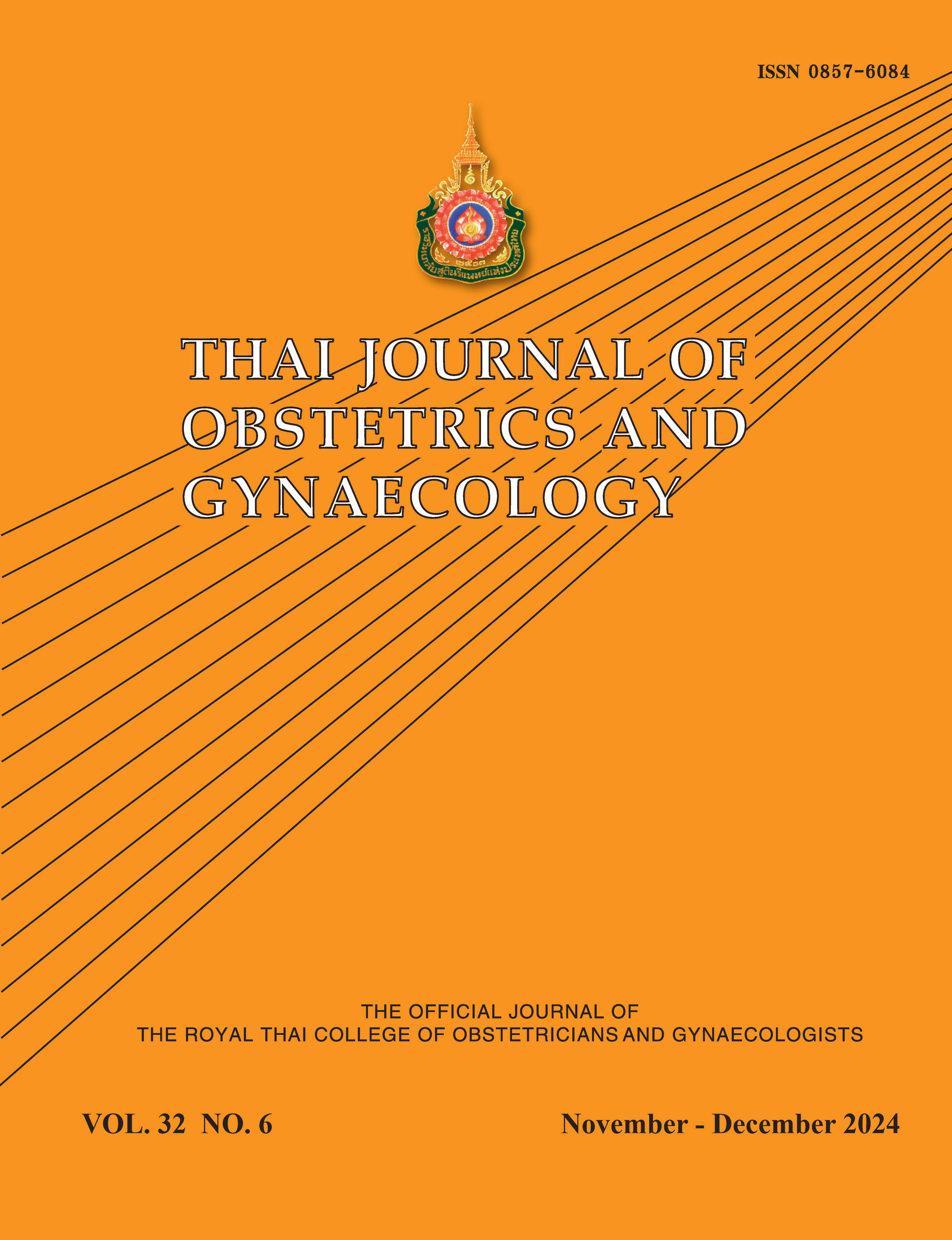Prevalence of Vitamin D Deficiency in Thai Women with Uterine Fibroids
Main Article Content
Abstract
Objectives: To determine the prevalence and associated factors of vitamin D deficiency in Thai women with uterine fibroids.
Materials and Methods: A cross-sectional observational study was conducted on 181 Thai women aged 21-49 diagnosed with at least one uterine fibroid with a diameter of 10 mm or greater by ultrasound. The volume of uterine fibroids was calculated using the ellipsoid volume formula. Serum concentrations of 25-hydroxyvitamin D (25(OH)D), parathyroid hormone, and calcium were measured. Then, the participants were stratified into three groups according to their vitamin D status.
Results: The prevalence of vitamin D deficiency in Thai women with uterine fibroids was 69.6%. The mean serum concentrations of 25(OH)D, parathyroid hormone, and calcium were 18.8 ± 5.8 ng/ml, 47.9 ± 17.8 pg/ml, and 9.2 ± 0.5 mg/dl, respectively. Neither serum 25(OH)D levels nor serum calcium levels were significantly associated with total uterine fibroid volume (crude mean difference (MD) = -0.01, 95% confidence interval (CI) = -0.02, 0.2, p = 0.949, crude MD = -0.19, 95%CI = -0.48, 0.1, p = 0.193, respectively). However, there was a significant association between serum parathyroid hormone (PTH) levels and total uterine fibroid volume (Adjusted MD = -0.02, 95%CI = -0.06, -0.001, p = 0.006).
Conclusion: Although a high prevalence of vitamin D deficiency was observed among Thai women with uterine fibroids, no significant association was found between low serum 25(OH)D levels and the presence of uterine fibroids.
Article Details

This work is licensed under a Creative Commons Attribution-NonCommercial-NoDerivatives 4.0 International License.
References
Ciebiera M, Włodarczyk M, Ciebiera M, Zaręba K, Łukaszuk K, Jakiel G. Vitamin D and uterine fibroids—review of the literature and novel concepts. Int J Mol Sci 2018;19:2051.
Parker WH. Etiology, symptomatology, and diagnosis of uterine myomas. Fertil Steril 2007;87:725-36.
Stewart EA, Cookson C, Gandolfo RA, Schulze‐Rath R. Epidemiology of uterine fibroids: a systematic review. BJOG 2017;124:1501-12.
Oskovi Kaplan ZA, Taşçi Y, Topçu HO, Erkaya S. 25-Hydroxy vitamin D levels in premenopausal Turkish women with uterine leiomyoma. Gynecol Endocrinol 2018;34:261-4.
Ciebiera M, Włodarczyk M, Słabuszewska-Jóźwiak A, Nowicka G, Jakiel G. Influence of vitamin D and transforming growth factor β3 serum concentrations, obesity, and family history on the risk for uterine fibroids. Fertil Steril 2016;106:1787-92.
Paffoni A, Somigliana E, Vigano’ P, Benaglia L, Cardellicchio L, Pagliardini L, et al. Vitamin D status in women with uterine leiomyomas. J Clin Endocrinol Metab 2013;98:E1374-E8.
Sabry M, Halder SK, Allah ASA, Roshdy E, Rajaratnam V, Al-Hendy A. Serum vitamin D3 level inversely correlates with uterine fibroid volume in different ethnic groups: a cross-sectional observational study. Int J Womens Health 2013:5:93-100.
Ciavattini A, Carpini GD, Serri M, Vignini A, Sabbatinelli J, Tozzi A, et al. Hypovitaminosis D and “small burden” uterine fibroids: Opportunity for a vitamin D supplementation. Medicine 2016;95:e5698.
Halder SK, Goodwin JS, Al-Hendy A. 1, 25-Dihydroxyvitamin D3 reduces TGF-β3-induced fibrosis-related gene expression in human uterine leiomyoma cells. J Clin Endocrinol Metab 2011;96:E754-E62.
Chailurkit L-o, Aekplakorn W, Ongphiphadhanakul B. Regional variation and determinants of vitamin D status in sunshine-abundant Thailand. BMC Public Health2011;11:1-7.
Soontrapa S, Bunyaratavej N, Rojanasthien S, Kittimanon N, Lektrakul S. Vitamin D status of Thai premenopausal women. J Med Assoc Thai 2009;92:S17-20.
Suebthawinkul C, Panyakhamlerd K, Yotnuengnit P, Suwan A, Chaiyasit N, Taechakraichana N. The effect of vitamin D2 supplementation on muscle strength in early postmenopausal women: a randomized, double-blind, placebo-controlled trial. Climacteric 2018;21:491-7.
Daniel WW. Biostatistics: a foundation for analysis in the health sciences: Wiley; 1978.
Holick MF, Binkley NC, Bischoff-Ferrari HA, Gordon CM, Hanley DA, Heaney RP, et al. Evaluation, treatment, and prevention of vitamin D deficiency: an Endocrine Society clinical practice guideline. J Clin Endocrinol Metab 2011;96:1911-30.
Munro MG, Critchley HO, Fraser IS, Committee FMD, Haththotuwa R, Kriplani A, et al. The two FIGO systems for normal and abnormal uterine bleeding symptoms and classification of causes of abnormal uterine bleeding in the reproductive years: 2018 revisions. Int J Gynaecol Obstet 2018;143:393-408.
Konradsen S, Ag H, Lindberg F, Hexeberg S, Jorde R. Serum 1, 25-dihydroxy vitamin D is inversely associated with body mass index. Eur J Nutr 2008;47:87-91.
Mai X-M, Chen Y, Camargo Jr CA, Langhammer A. Cross-sectional and prospective cohort study of serum 25-hydroxyvitamin D level and obesity in adults: the HUNT study. Am J Epidemiol 2012;175:1029-36.
de Oliveira LF, de Azevedo LG, da Mota Santana J, de Sales LPC, Pereira-Santos M. Obesity and overweight decreases the effect of vitamin D supplementation in adults: systematic review and meta-analysis of randomized controlled trials. Rev Endocr Metab Disord 2020;21:67-76.
Suhartono J, Astiarani Y. Association between body mass index and vitamin D serum in asian population: A systematic review. Public Health and Preventive Medicine Archive (PHPMA) 2022;10:69-79.
Ren Z, Zhao A, Wang Y, Meng L, Man‐Yau Szeto I, Yang C, et al. Association of serum 25‐hydroxy vitamin D with obesity‐related indices in Chinese adults: A cross‐sectional study. Food Sci Nutr 2021;9:2260-8.
Pourshahidi LK. Vitamin D and obesity: current perspectives and future directions. Proc Nutr Soc 2015;74:115-24.
World Health Organization. The Asia-Pacific perspective: redefining obesity and its treatment. 2000.
Weir EC, Goad DL, Daifotis AG, Burtis WJ, Dreyer BE, Nowak RA. Relative overexpression of the parathyroid hormone-related protein gene in human leiomyomas. J Clin Endocrinol Metab 1994;78:784-9.


